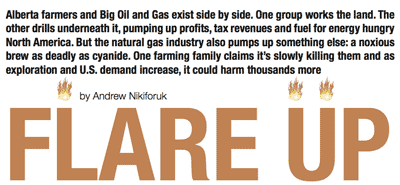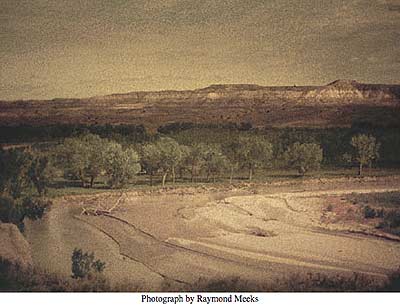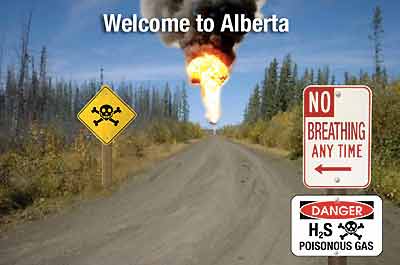Powder Keg
The gas industry has been busy in Wyoming's prairies and grasslands, building thousands of miles of roads and sinking more than 10,000 wells in the past three years. But in the Powder River basin, ranchers are joining environmentalists to try to still the drills.
See: C-Span Book TV Oct. 2, 2004. Bushwacked: Life in George W. Bush's America. Chapter: "Dick, Dubya, and Wyoming Methane." (152)
"...Environmental issues surrounding the development of CBM resources in the Powder River Basin and elsewhere have provoked conflict among mineral leaseholders, owners of the surface estates, and the public at large.
Citizen suits under the Clean Water Act and the Safe Drinking Water Act, and private tort actions, complicate the development of CBM resources. Despite geographic and geologic differences among areas in which CBM resources have been developed, the core environmental issues are consistent:
(1) Groundwater table drawdown due to pumping large quantities of groundwater.
(2) Disposal of large volumes of produced water.
(3) Methane contamination of shallow groundwater.
(4) Noise pollution from compressors and other sources.
(5) Air pollution from compressor exhaust gases, methane leakage, and dust.
(6) Surface disturbance from construction of roads, pipelines, and other facilities.
In CBM production, water is produced in large volumes and must be disposed of.
Because waters produced from coalbeds are often fresh, and subsurface disposal is expensive, disposal to surface drainages, wherever possible, carries a strong economic incentive.
Such disposal may erode soils and sediments, change microclimate, create unsustainable aquatic habitats, or salinize soils."
The Integrated Petroleum Environmental Consortium (IPEC) is a consortium of the University of Tulsa, the University of Oklahoma, Oklahoma State University and the University of Arkansas at Fayetteville.
Funded by the U.S. Environmental Protection Agency Office of Research and Development, the mission of IPEC is to increase the competitiveness of the domestic petroleum industry through a reduction in the costs of compliance with U.S. environmental regulations.
David Beers. "Tar Sands Expert Nikiforuk to Speak at UBC." The Tyee. 2010-09-09.
Tyee writer-in residence will reveal 'Who Regulates Canada's Oil Patch, and for Whom?'

“Sour gas is one of the most dangerous, toxic substances known to man,” he said. “Having a sour gas well 800 metres from your home is like having a child molester an in urban community. You never know when things are going to go wrong.”
Charlie Smith. "Andrew Nikiforuk: EnCana pipeline attacks are not ecoterrorism." Straight.com. 2008-10-17.
You can read another interview with Nikiforuk about his Tyee project here and find his work, so far, here.
See: The Globe and Mail. "Andrew Nikiforuk wins Rachel Carson medal." July 22, 2009.
See: Society of Environmental Journalists.SEJ's Rachel Carson Environment Book Award."
Read the results.
Here's why they did the survey.
There are probably no more important reforms to government than the ones that came with the passing of the Federal Freedom of Information ("FOI") Act. The law recognized in no uncertain terms that if government is to be of the people, by the people and for the people, the decisions and actions of the government must be open for review by the people.
The states, for the most part, followed the federal government in adopting open records laws.
Unfortunately, state FOI laws have proven to be almost uniformly weak and easy to undermine. The weakness and haphazard construction of the state laws has resulted in an information gap that significantly effects the citizenry's ability to examine even the most fundamental actions of government.
| BGA survey of FOI laws |
In the course of numerous investigations, Better Government Association investigators have been refused in our requests to review state contracts and performance measures, denied everything from documentation of ambulance response times to the documents reviewed when making budgeting decisions, and ignored by officials in nearly every major office at one time or another. Our experience told us that the FOI laws simply do not work very well in Illinois.
As a result of our hands-on experience with Illinois' lack of responsiveness, the BGA decided to find out where we stood in relationship to other states. We found that no one had completed any sort of national analysis of FOI laws, and that Illinois' relative strengths and weaknesses could not be measured without creating a new instrument to study the problem and without an analysis of each state's statutory provisions for FOI.
I was looking for the original article and ran this search on Google Scholar.
Analysis conducted by the Better Government Association
Staff: Terrance A. Norton, James M. Newcomb & Jay E. Stewart
Interns: Erika Washington and David Hall
Alabama, Alaska, Arizona, Pennyslvania, Montana, South Dakota, Tennessee, and Wyoming all got a bit fat F.
Powder River region of northern Wyoming.
See: SkyTruth: Upper Green River Valley - A View From Above
Every day millions of gallons of clean ground water in the American West are being contaminated, all in the rush to drill for gas.
BILL WEST: It took thousands of years to recharge these aquifers.
They're pumping it out and in maybe ten years it will be gone...
Molly Ivins has written about how the EPA was virtually dismantled as the Bush-Cheney administration handed over the role of oil and gas regulation to the oil and gas industry. While Governor of Texas, Bush allowed Texas industry to voluntarily comply with Federal Clean Air Regulations. Of the hundreds of Texas companies that might have volunteered, according to Ivins, only three did.
Bushwhacked by Molly ivins offers a critique of the presidency of George W. Bush, describing how the same flawed policies he used to govern Texas have affected health and safety standards, the economy, and the environment.
Paul Krugman. Strictly Business. Bushwhacked: Life in George W. Bush’s America Book Review. The New York Review of Books. November 20, 2003.
Chapter 9 of Bushwhacked, by Molly Ivins and Lou Dubose, entitled “Dick, Dubya, and Wyoming Methane,” tells you all you need to know about the Bush Interior Department.
We learn, in particular, that J. Steven Griles, the deputy secretary—and probably the real power in the department—has spent his career shuttling back and forth between being a government official and lobbying for the extractive industries.
And he has never worried much about ethical niceties—little things like recusing himself from decisions that affect his former clients. Moreover, Griles isn’t likely to be disciplined, even when he brazenly supports industry interests over the judgments of government experts.
After all, just about every other senior official at Interior, including Secretary Gale Norton, has a similar résumé. So it’s a very good bet that the new rules on mining-waste disposal don’t reflect a careful economic analysis of the pros and cons.
See: Ed Swartz: The Grass Isn't Growing
See: Stripping the West, a NOW Converstion with Bill Moyers.
See C-Span Book TV Oct. 2, 2004. Bushwacked: Life in George W. Bush's America. Read Chapter: "Dick, Dubya, and Wyoming Methane." (152)
See: U.S. Environmental Protection Agency (EPA): Hydraulic Fracturing Study (2010-2012)
Coalbed methane has rapidly become an important source of natural gas, particularly in the Inter-mountain West. The rapidity of its development has resulted in significant pressure on communities to deal with its environmental consequences.
Coalbed methane production often results in large quantities of water that are released as byproducts of production; in some cases, the water may inundate sensitive arid ecosystems, worsen surface water quality, and diminish undergroundwater supplies.
Noise, dust, and increased traffic; impairment of visibility and conflicts with recreation and other land use; impacts on wildlife and ecosystems; and other consequences of development have generated opposition in many communities.
Particularly vexing has been development on split estates, where surface owners do not own the mineral rights underneath their property and are required to cooperate with development that may disrupt the use and control of their land. This article examines the problems associated with coalbed methane development and offers a variety of suggestions for how conflicts could be reduced and how development could proceed in ways that are ecologically sustainable.
See: Hydraulic Fracturing Background Information | EPA (2004)
The Energy Policy Act passed by Congress in 2005 amended the Safe Drinking Water Act (SDWA) to exclude hydraulic fracturing fluids (except diesel fuel) related to energy production from regulation under the UIC program. States may choose to regulate hydraulic fracturing, however.
See: U.S. Environmental Protection Agency (EPA): Weston Wilson Whistle Blower Letter
See: Drilling Around the Law: Drinking Water Threatened by Toxic Natural Gas and Oil Drilling Chemicals
See: Hydraulic Fracturing of Oil and Gas Wells
See: Black Warrior Riverkeeper | Coalbed Methane
There are over four thousand coalbed methane wells in the Black Warrior River watershed. Tens of thousands of acres are leased to this practice, creating a massive network of roads and well pads. The extraction of coalbed methane involves a process known as hydraulic fracturing.
The Black River Watershed in Alabama provides water to over a million people.
See: Orion Magazine. November/December 2006. Taking On Goliath: Across the West, gas development is devastating land and people. | Now citizens are fighting back.
History of hydraulic fracturing | criticism of the 2004 EPA study.
I am writing on behalf of the Oil and Gas Accountability Project to provide an impartial analysis of the adequacy of the actions proposed in the subject report. I am a practicing hydrogeologist; I spent 32 years at the U.S. Geological Survey in both management and research positions. I left the USGS in 1995 to become a consultant. I have published more than 100 papers in the refereed scientific literature on various groundwater problems. My resume is attached to this comment.
Coal-bed methane is an energy source that in many places in the United States is associated with underground sources of drinking water (USDW). In some places the coal beds are the best aquifers in the area. In these places the development of CBM is incompatible with the continued use of the coal beds as an aquifer.
There is a direct conflict between national/state energy policy and the preservation of USDW. For example, in the Powder River Basin of Wyoming and Montana the Bureau of Land Management predicts, in their Final Environmental Impact Statement for CBM, that the development will lower the water levels in the coal measures by 600 to 800 feet over much of the basin.
This will make unusable several thousand private water wells that are completed in the coal beds. The law favors the development of the methane over the continued use of the coal beds as aquifers—in this case the best aquifers in the area.
...EPA discounted problems associated with hydraulic fractures based upon a limited sample of identified problems. They relied upon citizen reports almost exclusively. There were no independent surveys, no independent field investigation or other well sampling. The EPA exercise is incomplete at best.
...EPA seems caught up in the conflict between the National Energy Policy of the Bush Administration and the EPA mandate to protect USDW.
Letter written by Hydrology expert, John D, Bredehoeft, to Joan Harrigan-Farrelly: Chief Underground Injection Control, Prevention Program Office of Ground Water and Drinking Water Environmental Protection Agency.
RE: EPA draft study report:Evaluation of Impacts to Underground Sources of Drinking Water by Hydraulic Fracturing of Coalbed Methane Reservoirs: Subject: Federal Register August 28, 2002, Volume 67, Number 10, Pages55249-55251 (water Docket Id no. w-01-09-11).
See also: Bredehoeft, J. (2003). " From Models to Performance Assessment: The Conceptualization Problem." Ground Water, Vol. 41, No.5 pp 571-577.
Increasingly, models are being called on to predict the effects of human actions on natural ecosystems.
Despite the widespread use of models, there exists intense debate within the field over a wide range of practical and philosophical issues pertaining to quantitative modeling.
This book, which grew out of a gathering of leading experts at the Cary Conference IX, explores those issues.
See Chapter: "The Role of Quantitative Models in Science" (Oreskes).

U.S. Environmental Protection Agency (EPA MOA). 2003. A Memorandum of Agreement Between The United States Environmental Protection Agency and BJ Services Company, Halliburton Energy Services, Inc., and Schlumberger Technology Corporation: Elimination of Diesel Fuel in Hydraulic Fracturing Fluids Injected into Underground Sources of Drinking Water During Hydraulic Fracturing of Coalbed Methane Wells, Dec. 12, 2003.
"While the Companies do not necessarily agree that hydraulic fracturing fluids using diesel fuel endanger USDWs when they are injected into CBM production wells, the Companies are prepared to enter into this agreement in response to EPA’s concerns and to reduce potential risks to the environment." See Drilling Around the Law for a follow-up on this voluntary agreement. According to the Environmental Working Group's report, "This promise, however, applied to only coalbed methane wells -- a small portion of natural gas and oil wells drilled – and only to those drilled directly into underground sources of drinking water."

















